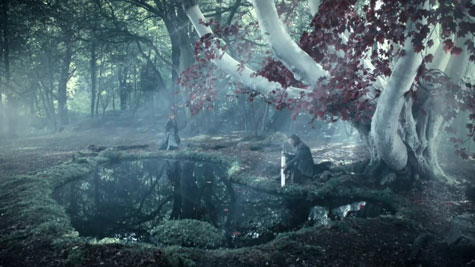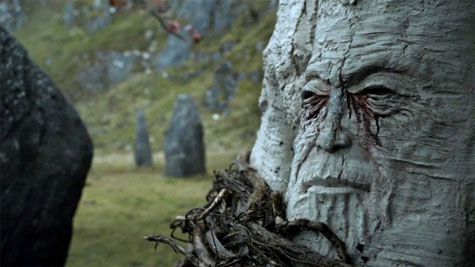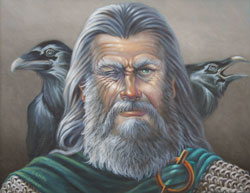
The Old Gods in George R. R. Martin’s series are based on an interesting blend of the faerie and Norse mythology. While two different mythological cosmologies, the blending makes a great deal of sense, as there were borrowings when the Norse—more famously known as Vikings—invaded and controlled parts of England, Scotland, and Ireland from 793-1066. This is easily long enough for cultural exchange and a kind of equilibrium of the two mythologies to blend. The Norse invaders brought their gods, the Norse, including Odin, Thor, Loki, Tyr, Freya, and the rest, whereas the native Celts had their own gods and the faerie, which are most like the Children of the Forest in Westeros.
The faeries are not like Tinkerbell. They are wilder and more natural, much like the Children are portrayed in the series. More importantly, the wonky length of the seasons in Game of Thrones might very well have a mythological explanation.
The faerie are comprised of two courts: Summer and Winter. The two courts are each ruled by a queen, the names of whom are popularized by Shakespeare’s plays A Midsummer Night’s Dream and Romeo and Juliet. In these, we meet Queen Titania of the summer court, and a reference to Queen Mab, the sovereign of the winter court. These two courts struggle with one another for ascendancy, but it’s always inevitable that one gives way to another as the seasons progress.
The fact that the seasons in Game of Thrones last significantly longer than a normal year might be a reflection of how Martin has taken this struggle to a different level, letting randomness enter the equation. Why should one court simply give up power because of the date? The other court should have to seize power—which extends the metaphor for the game of thrones. Summer and Winter are both struggling for that seat of power.
Check out our other Game of Thrones coverage!
The seasonal courts are often perceived in the same way as in the show. Summer is good and peaceful; winter is harsh and terrible. This preference for summer is related to the location of Scotland, Ireland, and England, far to the north and suffering bitterly cold winters. However, while winter is always harsher than summer, that doesn’t mean the faeries of the summer court were actually nicer. These are natural forces without morality.
The children of the wood are also very reminiscent of the faerie in that they are usually portrayed as childlike and mischievous. If disrespected, they can be very fierce and cruel. They certainly would have seemed alien, which is why the Andals drove them out and into the north.
The weirwoods, those trees with carved faces, are reminiscent of green men—carvings thought to represent nature, throughout Europe. Some people speculate that the green men are part of faerie mythology, but it’s not a symbol that is exclusive to that region of the world. The Norse, too, have a respect for trees. In fact, in the Norse creation, men and women are fashioned out of trees.

The Norse heavily influenced Martin’s Old Gods as well. The children used the weirwoods to look everywhere—as did Bran—which means they are all connected. While this could be an inference from the faerie, it is more likely a connection to how the Norse viewed the world tree, Yggdrasil, which connected the nine worlds. Its roots and branches connect not just Asgard (the home of the gods) to Midgard (Earth), but also to Niflheim (the frozen underworld) and Muspelheim (the land of fire).
The lands of ice and fire are also allusions to the seasons, though not as mild as the summer and winter courts of the faerie. The Norse creation myth begins with ice from Niflheim mingling with fire from Muspelheim in a location in the middle known as Ginnungagap (don’t worry, there’s no spelling test). These elemental forces are what drive creation, but they are not to be embraced as desirable. Niflheim is ruled by Hela, the goddess of disease and death, while Muspelheim is ruled by Surtur, who will end the world with his fire. To the Norse, these elemental forces are to be survived, not embraced. And, like in the series, it is always the rule of opposites; autumn and spring don’t receive nearly as much attention as summer and winter.
 The last major connection of the Norse and the Old Gods comes from Odin. The king of the Norse gods, as everyone who has seen the movie Thor knows, has only one eye. He sacrificed the other eye in exchange for knowledge. This knowledge gives him insight, which is far more valuable. He knows the past, and can see the future, reminiscent of the three-eyed raven from the series. The concept of a raven having this knowledge is also from Norse myth, as Odin has two ravens, Huginn and Munnin, which fly around the world gathering news. They return to him each night and tell him what they’ve seen and heard, keeping Odin informed.
The last major connection of the Norse and the Old Gods comes from Odin. The king of the Norse gods, as everyone who has seen the movie Thor knows, has only one eye. He sacrificed the other eye in exchange for knowledge. This knowledge gives him insight, which is far more valuable. He knows the past, and can see the future, reminiscent of the three-eyed raven from the series. The concept of a raven having this knowledge is also from Norse myth, as Odin has two ravens, Huginn and Munnin, which fly around the world gathering news. They return to him each night and tell him what they’ve seen and heard, keeping Odin informed.
These serve as the basis for the ravens in the series as well, who are sent out as messengers. The ravens are also said to be able to speak the language of the Children of the Forest, giving them a supernatural aspect similar to that of Odin’s ravens.
Martin has openly admitted to putting a lot of thought into the religions in his world, but they go beyond that, shaping the world itself. The priests of the Red God exhibit power, as do the Children, and all have witnessed the horrors of what the White Walkers can do. Whether this is simply powerful magic instead of actual gods, their power is real and was shaped into being by our own mythology.
Andy Adams is an adjunct professor of English at various colleges in the Phoenix area. He has an affectation for fedoras as they complement his villainous goatee. He’s been known to poke his head onto Twitter @A3Writer, but he’s never been big into birds. He blogs at A3writer.com about writing, teaching, and the conquest of fictional worlds—they’re more fun than the real world.
Read all posts by Andy Adams for Criminal Element.

Great stuff, Andy. Especially the connection between Odin and Bloodraven. Looking forward to the rest of these.
An excellent article, Andy. Appreciate the insight.
This is one of the most favorite movies, I have seen this movie many times from different platforms, but subdl subtitles from the best result from all, I have shared the link in the username, you can directly download or watch the movie online.
Thanks for Your sharing this wonderful article.
This is one of the most favorite movies, I have seen this movie many times from different platforms, Thesrtfile provides you the widest range of movie subtitles online and offline… Link Shared in username… Trust me and it Popads Free